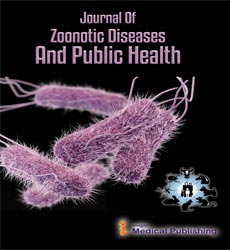Emergence and Treats of Influenza Viruses
Laurence Mont*
Department of Public Health, University College London, London, UK
- *Corresponding Author:
- Laurence Mont, Department of Public Health, University College London, London, UK; E-mail: laure.mont@cen.uk
Received: March 16, 2022, Manuscript No. IPJZDPH-22-11929; Editor assigned: March 19, 2022, PreQC No. IPJZDPH-22-11929 (PQ); Reviewed: April 02, 2022, QC No. IPJZDPH-22-11929; Revised: 5-Apr-2022, Manuscript No. IPJZDPH-22-11929 (R); Published: April 08, 2022, DOI: 10.36648/IPJZDPH/22.6.2
Citation: Mont L (2022) Emergence and Treats of Influenza Viruses. J Zoonotic Dis Public Health Vol:6 No:1
Editorial
Since the 1990s, the threat of influenza viruses to veterinary and human public health has increased. This coincides with the larger global populations of poultry, pigs, and people and with changing ecological factors. These factors include the redistribution of the human population to cities, rapid mass transportation of people and infectious agents, increased global land use, climate change, and possible changes in viral ecology that perpetuate highly pathogenic influenza viruses in the aquatic bird reservoir.
The emergence of H5N1, H7N9, and H9N2 subtypes of influenza a virus and the increased genetic exchange among influenza viruses in wild aquatic birds, domestic poultry, swine, and humans pose a continuing threat to humanity. The fundamental and practical knowledge of influenza A viruses is considered at the human animal interfaces to facilitate the development of novel control strategies and modified agricultural practices that will reduce or prevent interspecies transmission. Influenza viruses are of major concern to both veterinary and human public health because they continue to emerge and cause high mortality in domestic poultry and represent an on-going threat to human health. With the recognition that aquatic birds are the major reservoir of influenza viruses that sporadically transmit to domestic poultry, swine, and humans, there is acceptance of the "one world" concept of influenza. When influenza a viruses spread from the aquatic bird reservoir to domestic poultry, pigs, and people, they can evolve into viruses that cause mild or catastrophic diseases. For influenza viruses to spread from the aquatic bird reservoir to humans, they must evolve from intestinal tropism in wild aquatic birds with a body temperature of 42°C to respiratory tract tropism in humans with a body temperature of 37°C. Additionally, the virus must change its receptor specificity on the Hem Agglutinin (HA) from a binding preference for Sialic Acid (SA)-alpha 2, 3 in wild birds to SA-alpha 2, 6 in humans. Therefore, multiple genetic changes are required. The RNA genome of influenza has a high mutation rate, no proof reading mechanism, and is segmented, which enables the virus to be highly variable, continually acquire mutations, and frequently reassert. Agricultural practices that inadvertently facilitate the exchange of influenza a viruses at the wild bird domestic bird interface and at the domestic bird mammalian interface have been adopted as the need to provide additional animal protein to an increasing human population has grown. The basic knowledge of the properties of influenza a virus are considered that permit them to be so variable and the molecular determinants of host range and pathogenicity involved in the genesis of pandemic influenza viruses of domestic poultry, pigs, and humans.
Since the mid-1990s, the number of influenza threats to both veterinary and human public health has increased, including the genesis of triple reasserting viruses that contain gene segments from wild aquatic birds, swine, and humans. These include a pandemic H IN 1 influenza virus in 2009 that spread globally to humans and the H5N1 and H7N9 influenza viruses that continue to evolve and spread. Although neither the H5NI nor the H7N9 viruses have transmitted consistently among humans, the pandemic potential of these viruses cannot be overemphasized.
Influenza viruses are enveloped, negative-sense, single-stranded RNA viruses of the family Orthomyxoviridae, and they exist as 3 different types: A, B, and C. Influenza A and B viruses are associated with seasonal epidemics in humans, and influenza C viruses generally cause sporadic infections. Only influenza viruses are found in a number of mammalian and bird species and they are further classified into subtypes based on the antigenic properties of their spike-like surface glycoproteins, HA and Neuranumdase (NA). At present, 18 HA subtypes (HI—H18) and II NA subtypes (NI—NII) have been identified. Each virus contains I HA and 1 NA subtype, and most of the influenza a subtypes can be found in numerous possible combinations in aquatic bird populations, except H17, H18, N10, and NI1, which have been found only in bats. In particular, wild waterfowl are considered the main natural reservoir for influenza A viruses; thus, they play a central role in influenza A virus ecology. Conversely, only a few influenza subtypes have become established in mammals, and HI, H2, and H3 are the only ones that have caused epidemic and pandemic influenza in humans.
Open Access Journals
- Aquaculture & Veterinary Science
- Chemistry & Chemical Sciences
- Clinical Sciences
- Engineering
- General Science
- Genetics & Molecular Biology
- Health Care & Nursing
- Immunology & Microbiology
- Materials Science
- Mathematics & Physics
- Medical Sciences
- Neurology & Psychiatry
- Oncology & Cancer Science
- Pharmaceutical Sciences
